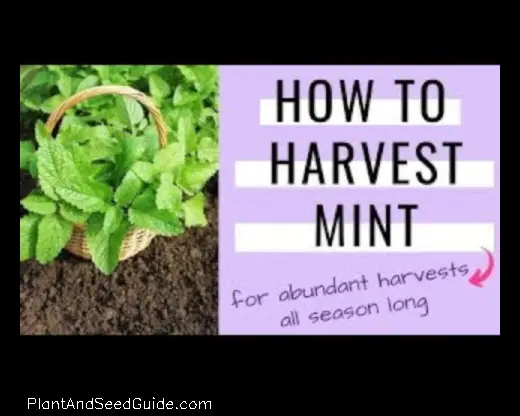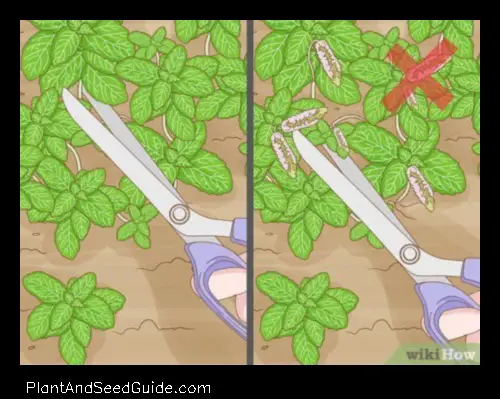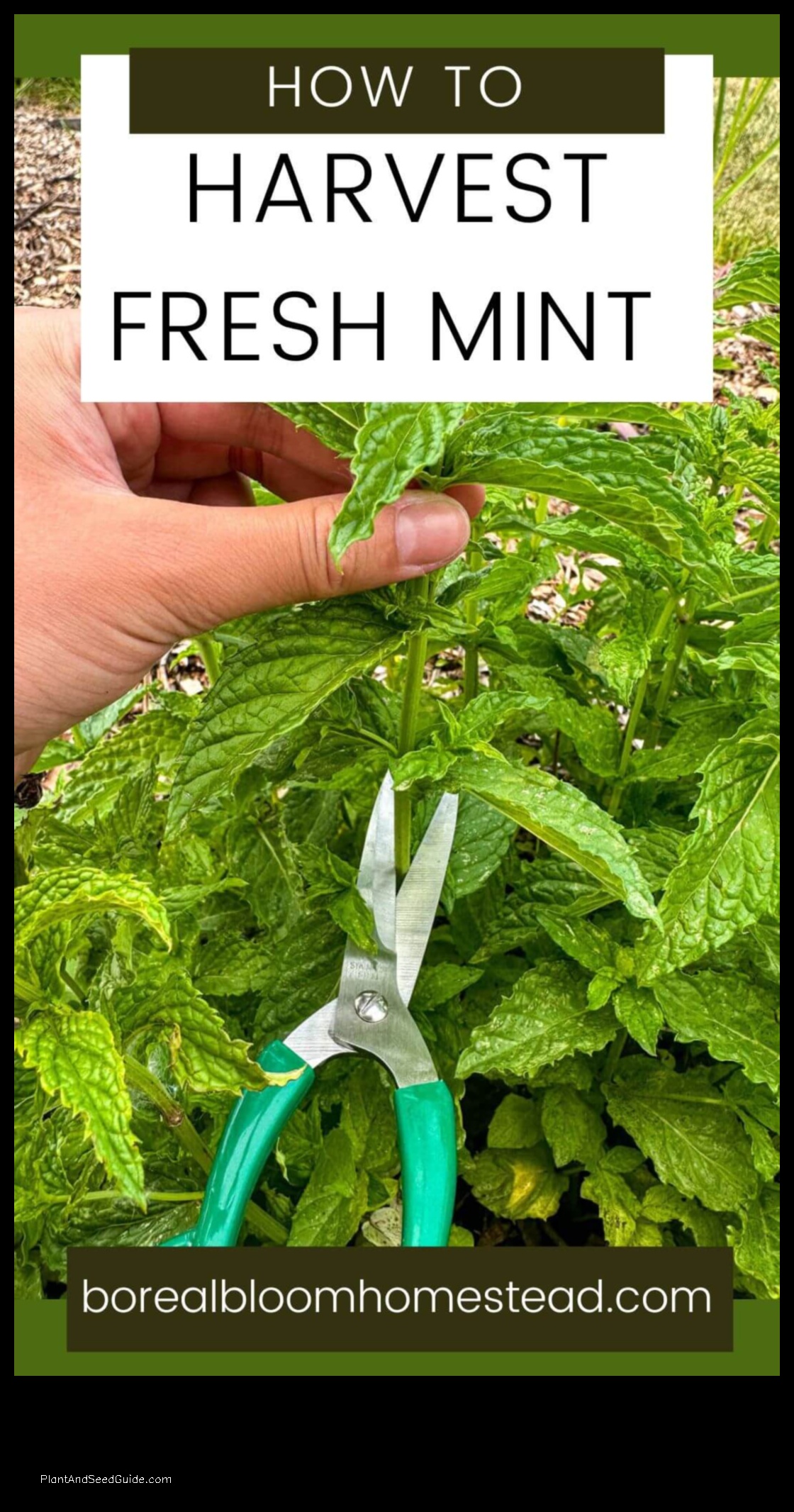

How to cut mint without killing the plant
Mint is a popular herb that can be used in a variety of dishes. However, it can be difficult to harvest mint without damaging the plant. This article will provide tips on how to cut mint without killing the plant.
The best time to cut mint is in the morning, when the leaves are fresh and full of flavor. To cut mint, use a sharp knife or scissors to remove the leaves from the stem. Be sure to leave a few inches of stem attached to the plant so that it can continue to grow.
You can also propagate mint by taking a cutting from the plant. To do this, cut a 4-inch stem from the plant and remove the leaves from the bottom half of the stem. Dip the stem in rooting hormone and plant it in a pot of moist potting soil. Keep the soil moist and the plant will root in about 2-4 weeks.
Mint is a hardy plant that can tolerate a variety of conditions. However, it does best in full sun or partial shade and moist soil. Mint can be grown in containers or in the ground.
Mint is a versatile herb that can be used in a variety of dishes. It can be added to salads, soups, sauces, and drinks. Mint can also be used to make tea or infused in water.
Loading... Seconds Left for
Miniature Orchid Terrarium Gallery!

Mint is a delicious and nutritious herb that can add flavor to a variety of dishes. By following these tips, you can enjoy fresh mint all season long without damaging the plant.
| Feature |
Answer |
| How to cut mint |
Use sharp scissors or shears to cut the stems just above the leaves. |
| Mint care |
Water mint regularly, especially during hot weather. |
| Mint propagation |
Take a cutting from the plant and place it in water or soil. |
| Mint harvesting |
Harvest mint leaves as needed. |
| Mint pruning |
Prune mint plants to keep them bushy and healthy. |

How to cut mint without killing the plant
To cut mint without killing the plant, you should:
- Use sharp scissors or shears to make a clean cut.
- Cut the stems just above a leaf node.
- Do not cut more than one-third of the plant at a time.
- Water the plant well after harvesting.
By following these tips, you can harvest mint without damaging the plant and enjoy its fresh flavor all season long.
When to cut mint
The best time to cut mint is in the morning, after the dew has dried. This will help to prevent the spread of disease.
You can als
o cut mint in the evening, but be sure to dry the leaves before storing them.
It is important to note that mint is a perennial plant, which means that it will come back year after year. Therefore, you do not need to cut it all the way back to the ground.
Instead, you can simply trim the stems back to about 2 inches long. This will encourage new growth and keep the plant looking its best.
If you are
planning to use mint in a recipe, you can cut the leaves off the stems and store them in a sealed container in the refrigerator for up to two weeks.
You can also freeze mint leaves by placing them in a single layer on a baking sheet and freezing them for several hours.
Once the leaves are frozen, you can transfer them to a sealed container and store them in the freezer for up to six months..
When using frozen mint leaves, be sure to thaw them completely before using them in a recipe.
To cut mint without killing the plant, you should use a sharp knife or scissors to make a clean cut just above the leaf node. This will help to encourage new growth and prevent the plant from becoming damaged.
You should also avoid cutting the mint too close to the ground, as this can damage the roots. Instead, cut the mint stems about 1-2 inches above the ground.
When cutting mint, it is also important to choose the right time of day. Mint is best harvested in the morning, when the leaves are fresh and full of flavor.
Finally, be
sure to store your mint properly after cutting it. Mint can be stored in the refrigerator for up to 2 weeks, or in the freezer for up to 6 months.

The best way to cut mint
The best way to cut mint is to use a sharp pair of scissors or shears. Cut the stems just above the leaf nodes, which are the small bumps on the stem where the leaves are attached. This will encourage new growth and help the plant to stay healthy.
When cuttin
g mint, be sure to leave a few inches of stem on each plant so that it can continue to grow. You can also pinch off the leaves from the stems, but this will not encourage new growth.
Mint can be cut at any time of year, but it is best to do so when the leaves are fresh and green.
If you are cutting mint for storage, it is best to do so in the morning when the leaves are cool and dry..
Mint can be stored in the refrigerator for up to two weeks, or in the freezer for up to six months. To store mint in the refrigerator, place the leaves in a sealed container or bag. To store mint in the freezer, place the leaves in a freezer-safe bag or container and freeze.
VHow_to_store_mint">VHow to store mint
Mint can be stored in a variety of ways, depending on how you plan to use it. Here are a few tips:
Fresh mint: To store fresh mint, place the stems in a glass of water and cover with plastic wrap. Store the glass in the refrigerator for up to 2 weeks.
Dried mint: To dry mint, tie the stems together and hang them upside down in a cool, dry place. The mint will be dry when the leaves crumble easily. Store the dried mint in an airtight container in a cool, dark place.
Mint oil: To make mint oil, fill a glass jar with fresh mint leaves and cover with olive oil. Let the mixture sit for 2-3 weeks, then strain out the leaves. Store the mint oil in an airtight container in a cool, dark place.
Mint can also be frozen for later use.
To freeze mint, wash the leaves and pat them dry..
Place the leaves in a single layer on a baking sheet and freeze for 1-2 hours. Once the leaves are frozen, transfer them to a freezer-safe bag or container. Mint can be frozen for up to 6 months.
When using
frozen mint, thaw the leaves in the refrigerator overnight or at room
temperature for a few hours. You can also use frozen mint in smoothies, iced tea, or other
cold drinks.
How to use mint
Mint can be used in a variety of ways, both fresh and dried. Here are a few ideas:
- Add fresh mint leaves to salads, soups, and sauces.
- Make a mint tea by steeping fresh mint leaves in hot water.
- Use mint in cocktails, such as mojitos and mint juleps.
- Make a mint extract by infusing vodka with fresh mint leaves.
- Dry mint leaves and use them in potpourris, sachets, and other crafts.
Mint is a versatile herb that can add flavor and freshness to a variety of dishes. Experiment with different ways to use mint to find your favorites!
Pests and diseases of mint
Mint is a relatively pest– and disease-free plant, but it can occasionally be affected by a few problems. Here are some of the most common pests and diseases of mint, and how to deal with them:
Aphids: Aph
ids are small, sap-sucking insects that can damage mint plants. They can be controlled by spraying the plants with a water-and-soap solution, or by using an insecticidal soap.
Mealybugs: Mealybugs are small, white insects that feed on the sap of mint plants. They can be controlled by spraying the plants with a horticultural oil, or by using a commercial insecticidal soap.
Slugs and snails: Slugs and snails can eat the leaves of mint plants. They can be controlled by using a slug and snail bait, or by hand-picking them off the plants.
Rust: Rust is a fungal disease that can cause
brown spots on the leaves of mint plants. It can be controlled by spraying the plants with a fungicide.
Powdery mildew: Powdery mildew is a fungal disease that causes a white powdery coating on the leaves of mint plants. It can be controlled by spraying the plants with a fungicide.
In addition to pests and diseases, mint can also be affected by a variety of environmental factors, such as drought, heat, and cold. It is important to make sure that mint plants are getting the right amount of water, sunlight, and nutrients in order to stay healthy.
Growing mint
Mint is a relatively easy plant to grow, and it can be grown in a variety of climates. It prefers full sun, but can tolerate partial shade. It does best in well-drained soil, but it can tolerate a variety of soil types. Mint is a drought-tolerant plant, but it will do best if it is watered regularly.
Mint can be
propagated by seed, division, or cuttings. Seed propagation is the slowest method, but it is also the most reliable. Division is the quickest method, and it is also relatively easy. Cuttings are the easiest method, but they are not as reliable as seed or division.
Mint can be grown in containers or in the ground.
If you are growing mint in containers, make sure that the container is large enough to accommodate the plant’s roots..
If you are growing mint in the ground, make sure that the soil is well-drained.
Mint is a versatile plant that can be used in a variety of ways. It can be used in salads, soups, sauces, and drinks. It can also be used to make tea, jelly, and candy.
Mint is a p
opular herb that is easy to grow and use. It is a great addition to any
garden or kitchen.
FAQ
How do I cut mint without damaging the plant?
To cut mint without damaging the plant, use sharp scissors or a sharp knife to cut the stems just above the soil level. Be careful not to damage the roots of the plant.
How often should I harvest mint?
You can harvest mint as often as you like, but it is best to harvest it in the morning when the leaves are fresh and full of flavor. To harvest mint, simply cut the stems just above the soil level.
How do I
care for mint after harvesting?
After harvesting mint, water the plant well and fertilize it with a light application of compost or organic fertilizer. You can also prune the plant to keep it looking its best.
How do I propagate mint?
To propagate mint, you can take a cutting from the plant and grow it into a new plant. To do this, simply cut a 4- to 6-inch stem from the plant and remove the bottom leaves. Dip the stem in rooting hormone and plant it in a pot of moist potting soil. Keep the soil moist and the plant in a warm location. The plant should start to grow roots within a few weeks.
_posts">
Recent PostsHello, I'm Katie Owen! I am the voice behind "plantandseedguide," inviting you on a journey through the enchanting world of greenery. The magical beauty of nature and the fascinating realm of plants have always captivated me, leading me to this space.
Latest posts by Katie Owen
(see all)



